Timeline of Alberta history
Below is a brief timeline covering the history of Alberta and its predecessor states.
| This article is part of a series on |
| Alberta |
|---|
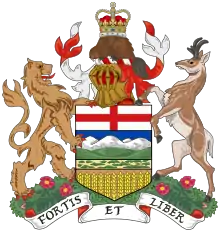 |
| Topics |
| History |
| Politics |
| Timeline of Albertan history |
Pre-history
| Date | Event | Reference |
|---|---|---|
| c. 8000 BC | Head-Smashed-in-Buffalo-Jump is first used, archaeology indicates. | [1] |
Pre-Confederation
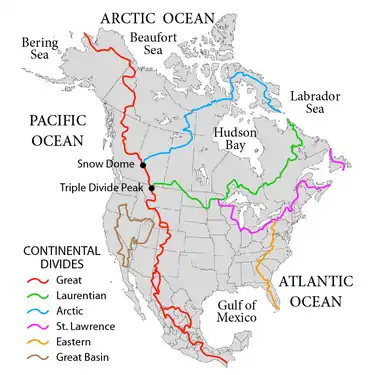
The Watersheds of North America displayed over the continent played important roles in the determination of political boundaries established across North America, including Alberta. They also served as important conduits for early explorers.
| Date | Event | Reference |
|---|---|---|
| May 2, 1670 | King Charles II of England grants the Hudson's Bay Company (HBC) a royal charter for "the sole Trade and Commerce of all those Seas, Streights, Bays, Rivers, Lakes, Creeks, and Sounds, in whatsoever Latitude they shall be, that lie within the entrance of the Streights commonly called Hudson's Streights... which are not now actually possessed by any of our Subjects, or by the Subjects of any other Christian Prince or State... and that the said Land be from henceforth... called Rupert's Land". Rupert's Land goes on to become part of Alberta. | [2] |
| 1715 | Captain Swan reports finding "gum or pitch" in the region now known as the Athabasca oil sand. The Captain's report is the first known to mention the oil sands. | [3] |
| September 11, 1754? | Anthony Henday, believed to be the first European to explore the area, enters present day Alberta. | [4] |
| 1778 | Peter Pond establishes the first fur trading post in Alberta[5] and submits a map of the area to the United States Congress and Lt. Governor of Quebec on March 1, 1785.[6] | [5][6] |
| 1788 | Alexander Mackenzie mentions "bituminous" substances banking the Athabasca river. Mackenzie also co-founds Fort Chipewyan. | |
| July 3, 1789 | Alexander Mackenzie embarks on his 1789 expedition to the Arctic Ocean from Fort Chipewyan. | |
| February 12, 1793 | Peter Fidler reports coal deposits on the banks of Kneehills Creek, near the Red Deer River, north of present-day Drumheller. Fidler is the first known to mention coal deposits on the Prairies. | [7] |
| 1795 | Fort Edmonton established by the HBC as a trading post. | |
| December 20, 1803 | Mississippi drainage lands lying within present day Alberta are transferred to United States with the Louisiana Purchase, which was signed on April 30, 1803, comes into effect. | |
| October 18, 1840 | Robert Rundle arrives at Fort Edmonton as the first permeant cleric to the area. |
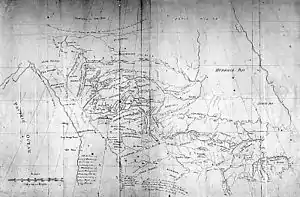
Copy of a map presented to the United States Congress and the Lt. Governor of Quebec by Peter Pond.
Post-Confederation

Territorial evolution of the province of Alberta within Canada since Confederation, 1867
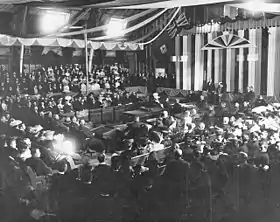
Alberta's first legislature, Edmonton, 1906
| Date | Event | Reference |
|---|---|---|
| July 15, 1870 | Rupert's Land and the North-Western Territory are combined under the new name of the North-West Territories, parts of which will become part of Alberta. | [8] |
| October 25, 1870 | Battle of the Belly River occurs. The battle is the last major conflict between the Cree (the Iron Confederacy) and the Blackfoot Confederacy, and the last major battle between First Nations on Canadian soil. | |
| October 1, 1874 | First North-West Mounted Police outpost in Alberta at Fort Macleod is established. | |
| September 1875 | Fort Brisebois, later renamed Fort Calgary in 1876 by James MacLeod, established by Éphrem Brisebois. | [9] |
| August 23, 1876 | Treaty 6 receives its first signatories, ceding much of central Alberta to the crown. | |
| September 22, 1877 | Treaty 7 is signed, ceding much of southern Alberta to the crown. | |
| May 2, 1882 | North-West Territories, which then included the future land of Alberta, is divided into provisional districts, among them being the divisions of Alberta, Assiniboia, and Athabasca. | [10] |
| October 13, 1882 | Alexander Galt's company, the North Western Coal and Navigation Company, opens its first drift mine. The community of Coalbanks, later named Lethbridge, establishes itself around the mine. | [11] |
| August 10, 1883 | Canadian Pacific Railway (CPR) construction reaches Calgary, having entered Alberta in early May. | [12] |
| 1883 | Langevin Siding, later renamed Carlstadt, and later Alderson, serves as the first discovery point for natural gas by CPR employees accidentally drilling for water. | [13] |
| April 2, 1885 | Frog Lake Massacre occurs as the North-West Rebellion stretches into modern day Alberta. A Cree raiding party attacks the town of Frog Lake (then, in the District of Saskatchewan). | |
| June 23, 1887 | Rocky Mountains Park (later renamed Banff National Park), is created by the Rocky Mountain Park Act. | [14] |
| January 1, 1894 | Calgary incorporated as a city. | [9] |
| November 7, 1898 | Klondike Trail construction is started by Thomas Chalmers on behalf of the North-West Territorial government. | [15] |
| June 21, 1899 | Treaty 8 is signed, ceding much of Northern Alberta to the crown. | |
| April 29, 1903 | Frank Slide, Canada's deadliest rockslide occurs in the town of Frank, then North-West Territories. | |
| November 7, 1904 | Edmonton incorporated as a city. | [16] |
| September 1, 1905 | The Alberta Act creates Alberta as a province from the North-West Territories. | |
| November 9, 1905 | 1st Albertan general election occurs, the Alberta Liberal Party defeats the Alberta Conservative Party led by R.B. Bennett. Bennett will become the 11th Prime Minister of Canada. | |
| January 11, 1911 | Lowest temperature every recorded in Alberta, -60.6°C at Fort Vermillion. | |
| September 3, 1912 | Alberta Legislature Building opened by Governor General of Canada, the Duke of Connaught. | [17] |
| June 19, 1914 | Hillcrest mine disaster, Canada's deadliest coal mining accident killing 189 workers. | |
| July 21, 1915 | 1915 Alberta liquor plebiscite occurs with 61% voting in favour of prohibition. | [18] |
| April 19, 1916 | Women's suffrage movement prevails in Alberta, women earn the right to vote, being the third province to grant the right with the passage of the Equal Suffrage Statutory Law Amendment Act. | [19] |
| October 2, 1918 | Spanish Influenza causes the Alberta Board of Public Health to declare all citizens be masked in public. Around 4,700 people die and over 31,000 cases are reported in Alberta. | [20][21] |
| July 18, 1921 | 5th Albertan general election occurs, the United Farmers of Alberta defeats the incumbent Liberal's. | |
| November 5, 1923 | 1923 Alberta prohibition plebiscite occurs with 58% voting in favour of clause (d), enabling government sale of liquor, and ending total prohibition from the 1915 Alberta prohibition plebiscite. | [22] |
| June 16, 1926 | The City of Edmonton receives a licence to operate airport, later named Blatchford Field, the first municipal airport in Canada. | [23] |
| April 24, 1928 | Edwards v Canada decision is released, favouring the all-Albertan group, the Famous Five. The decision decides women are persons under the law. | [24] |
| December 14, 1929 | Alberta Natural Resources Act passed, transferring control of natural resources and Crown land to the province. | [25] |
| July 2, 1934 | Brownlee sex scandal, captures widespread attention in the province, resulting in the premier's resignation. The UFA's was swiftly defeated in the following election. | [26] |
| September 29, 1938 | Alberta Treasury Branches established as a provincially owned bank. |
Post World War II
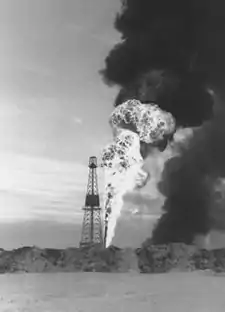
Leduc No. 1 well
| Date | Event | Reference |
|---|---|---|
| February 13, 1947 | Leduc No. 1, the first major oil discovery in Alberta is made beginning the petroleum industry in Alberta. | |
| August 30, 1971 | 17th Alberta general election occurs. The Progressive Conservatives win a majority, led by Peter Lougheed, displacing the incumbent majority of the Social Credit party—ending 36 years of the party's successive victories. | |
| May 19, 1976 | Alberta Heritage Savings Trust Fund created upon Alberta Heritage Savings Trust Fund Act receiving royal assent. The Heritage fund remains the only sovereign wealth fund in Canada. | [27] |
| October 28, 1980 | National Energy Program is announced by the federal Trudeau government, creating anger and resentment in the West and set to take effect on January 1, 1981. | [28] |
| September 15, 1981 | West Edmonton Mall, at the time the world's largest, opens. | |
| September 25, 1985 | Royal Tyrell Museum of Palaeontology opened. | |
| June 14, 1986 | The Mindbender derails, killing three people | |
| July 31, 1987 | The Edmonton tornado occurs, killing 27 people | |
| February 13, 1988 | 1988 Winter Olympics open in Calgary with closing ceremonies on February 28. | |
| June 19, 2013 | 2013 Alberta floods begins, causing some of the worst flooding damage in Alberta's history. | |
| May 5, 2015 | 29th Alberta general election occurs. The Alberta New Democratic Party win a majority, displacing the incumbent majority of the Progressive Conservative party—ending 44 years of the party's successive victories (since the 17th general election). | |
| May 1, 2016 | 2016 Fort McMurray wildfire begins, displacing over 88,000 people from their homes. | |
| December 2, 2018 | Rachel Notley#Oil_curtailments announced to take affect in January 2019, limiting production to 3.56 million barrels per day. | |
| April 16, 2019 | 30th Alberta general election occurs. The United Conservative Party win a majority, displacing the incumbent majority of Alberta NDP after one-term. | |
| January 8, 2020 | The shoot-down of Ukraine International Airlines Flight 752 in Iran kills 51 Canadians, including 13 Edmontonians, of whom 10 were faculty at the University of Alberta. This is believed to be the most Edmontonians killed in a single event since the 1987 tornado, and deadliest day in the history of the University. | |
| February 23, 2020 | Teck Resources withdraws its application to build the Frontier Mine in northern Alberta despite having spent more than one billion dollars over then ten years on the project. | |
| March 17, 2020 | COVID-19 causes the government of Alberta to declare a state of emergency.[29] The first person in Alberta dies from the virus on March 19.[30] | |
| January 1, 2021 | A helicopter crash kills 4 people in Northern Alberta.[31][32] |
Timeline of Alberta Premiers
 |
Other Alberta timelines
References
- Buffalo Tracks: Educational and scientific studies from Head-Smashed-in-Buffalo-Jump (PDF). Alberta Government.
- "Text of HBC's Royal Charter". HBC Heritage. Retrieved Feb 14, 2020.
- "Swan (Captain Swan)". Dictionary of Canadian Biography.
- "Peel 35, Henday, Anthony".
- "Biography — Peter Pond". Dictionary of Canadian Biography.
- "Peter Pond: Map Maker of the Northwest (1740-1807)" (PDF). UCalgary.
- "Peter Fidler". Government of Alberta.
- "Deed of Surrender". HBC Heritage. Retrieved Feb 14, 2020.
- "The City of Calgary - Historical Information". City of Calgary.
- Canada (1886). Acts of the Parliament of the Dominion of Canada, Volumes 1-2. p. xviii.
- "Alberta's First Coal Mining Community". Alberta Government.
- "The Canadian Pacific Railway in Western Canada". Atlas of Alberta Railways.
- "Alberta's First Natural Gas Discovery". Petroleum History Society.
- "Rocky Mountains Park Act, 1887". Parks Canada History.
- "Chalmers Trail". Klondike Trail Society. Archived from the original on 2008-12-21.
- "CITY OF EDMONTON POPULATION, HISTORICAL". Government of Edmonton.
- "Alberta Legislature Building". Heritage Resources Management Information System.
- "The Edmonton Bulletin, July 21, 1915". Edmonton Peel Archive.
- "Equal Suffrage Statutory Law Amendment Act" (PDF). Alberta Legislature.
- Yousif, Nadine (Nov 26, 2018). "100 years later, Alberta remembers the devastation of the Spanish Flu". The Star.
- Zurowski, Monica (March 13, 2020). "In 1918, Spanish flu pulled into Calgary on a train. Here's how the city coped". Calgary Herald.
- Hamill, Sarah (2015). "Prohibition Plebiscites on the Prairies: (Not-So) Direct Legislation and Liquor Control in Alberta, 1915–1932" (PDF). Law and History Review. 33 (2): 377–410. doi:10.1017/S0738248015000097.
- https://www.albertaaviationmuseum.com/wp-content/uploads/2016/12/Blatchford-Field-Tingley-Article-1.pdf
- "(J) The Person's Case: Supreme Court of Canada decision (April 24, 1928)". Nellie McLung Foundation.
- "Alberta Natural Resources Act". Government of Canada.
- "MacMillan v. Brownlee, 1934 CanLII 376 (AB QB)". CanLII.
- "Alberta Heritage Savings Trust Fund Historical Timeline" (PDF). Alberta Government. February 28, 2020.
- The Budget 1980 (PDF). 1980. p. 9.
- "Update 4: COVID-19 pandemic in Alberta (March 17 at 3:30 p.m.)". Alberta Government. March 17, 2020.
- "Update 6: COVID-19 pandemic in Alberta (March 19 at 5 p.m.)". Alberta Government. Mar 19, 2020.
- "4 Members Of Family Killed In Alberta Helicopter Crash". HuffPost Canada. 2021-01-02. Retrieved 2021-01-11.
- "Family of four killed in helicopter crash in northern Alberta". edmontonjournal. Retrieved 2021-01-11.
This article is issued from Wikipedia. The text is licensed under Creative Commons - Attribution - Sharealike. Additional terms may apply for the media files.